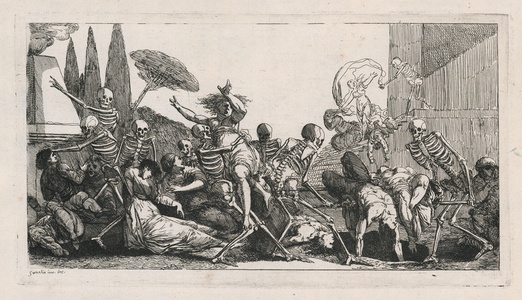| Method | Etching |
| Artist | Jacques Gamelin |
| Published | Gamelin inv. inc. [A Toulouse, De l'Imprimerie de J.F. Desclassan, Maitre-ez-Arts, pres le Place Royale. M.DCC.LXXIX. Avec Permission] |
| Dimensions | Image 130 x 252 mm, Plate 145 x 265 mm, Sheet 542 x 405 mm |
| Notes |
A memento mori vignette showing a crowd of skeletons abducting the living, prepared by Gamelin for his masterwork, the "Nouveau Recueil D'Osteologie et de Myologie, Dessine d'Apres Nature." The scene is set in an Italianate garden, its pines and cedars reminiscent of Roman cemeteries. Before a large stone funerary monument, a group of people cower at the advance of a troupe of marauding skeletons. Some have fainted from the shock, others scream in terror, while those that have already died are gathered up and bundled onto a stretcher carried by a pair of skeletons to the right of the scene. At centre, a young woman is lifted aloft by one of her grim captors, her hair flying and her arms flailing as she is carried to the awaiting pile of corpses. In the background, a trio of figures flee a single skeleton down a flight of stairs, one of them tripping and falling headlong from the top. Gamelin's "Nouveau Recueil D'Osteologie et de Myologie, Dessine d'Apres Nature" is an usual book. Straddling the line between scientific treatise and artist's patternbook, it is ostensibly a collection of illustrations of the skeletal and muscular systems. Interspersed between Gamelin's more traditional anatomical plates are scenes and vignettes playing with memento mori and vanitas themes. Some are serious in tone, showing the corpses of fallen men and animals on battle fields, the dissected bodies of condemned criminals, or explorations of crucifixion, while others are humorous or just plain bizarre, with cavorting skeletons harrassing society ladies in their finery, dancing jigs in Gothic operettas, or carrying off the living to join in various danses macabres. Jacques Gamelin (1738-1803) was a French painter and engraver, active in Toulouse and Carcassone. He is best known for his paintings of battle scenes, as well as a collection of engravings of anatomical subjects published in the Nouveau Recueil D'Osteologie et de Myologie, Dessine d'Apres Nature. Condition: Strong clean impression on a full sheet. Letterpress text in French and Latin above. Time toning to edges of sheet. Blank on verso. |
| Framing | unmounted |
| Price | £175.00 |
| Stock ID | 50239 |

